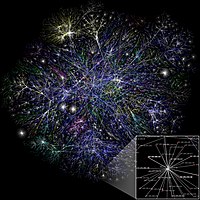
Photo from wikipedia
BackgroundThe accuracy of any 3D-QSAR, Pharmacophore and 3D-similarity based chemometric target fishing models are highly dependent on a reasonable sample of active conformations. Since a number of diverse conformational sampling… Click to show full abstract
BackgroundThe accuracy of any 3D-QSAR, Pharmacophore and 3D-similarity based chemometric target fishing models are highly dependent on a reasonable sample of active conformations. Since a number of diverse conformational sampling algorithm exist, which exhaustively generate enough conformers, however model building methods relies on explicit number of common conformers.ResultsIn this work, we have attempted to make clustering algorithms, which could find reasonable number of representative conformer ensembles automatically with asymmetric dissimilarity matrix generated from openeye tool kit. RMSD was the important descriptor (variable) of each column of the N × N matrix considered as N variables describing the relationship (network) between the conformer (in a row) and the other N conformers. This approach used to evaluate the performance of the well-known clustering algorithms by comparison in terms of generating representative conformer ensembles and test them over different matrix transformation functions considering the stability. In the network, the representative conformer group could be resampled for four kinds of algorithms with implicit parameters. The directed dissimilarity matrix becomes the only input to the clustering algorithms.ConclusionsDunn index, Davies–Bouldin index, Eta-squared values and omega-squared values were used to evaluate the clustering algorithms with respect to the compactness and the explanatory power. The evaluation includes the reduction (abstraction) rate of the data, correlation between the sizes of the population and the samples, the computational complexity and the memory usage as well. Every algorithm could find representative conformers automatically without any user intervention, and they reduced the data to 14–19% of the original values within 1.13 s per sample at the most. The clustering methods are simple and practical as they are fast and do not ask for any explicit parameters. RCDTC presented the maximum Dunn and omega-squared values of the four algorithms in addition to consistent reduction rate between the population size and the sample size. The performance of the clustering algorithms was consistent over different transformation functions. Moreover, the clustering method can also be applied to molecular dynamics sampling simulation results.
Journal Title: Journal of Cheminformatics
Year Published: 2017
Link to full text (if available)
Share on Social Media: Sign Up to like & get
recommendations!